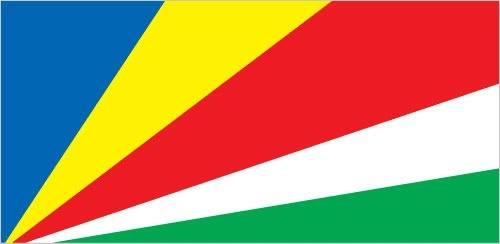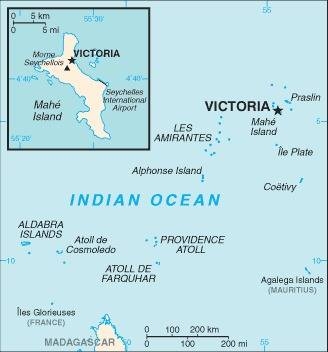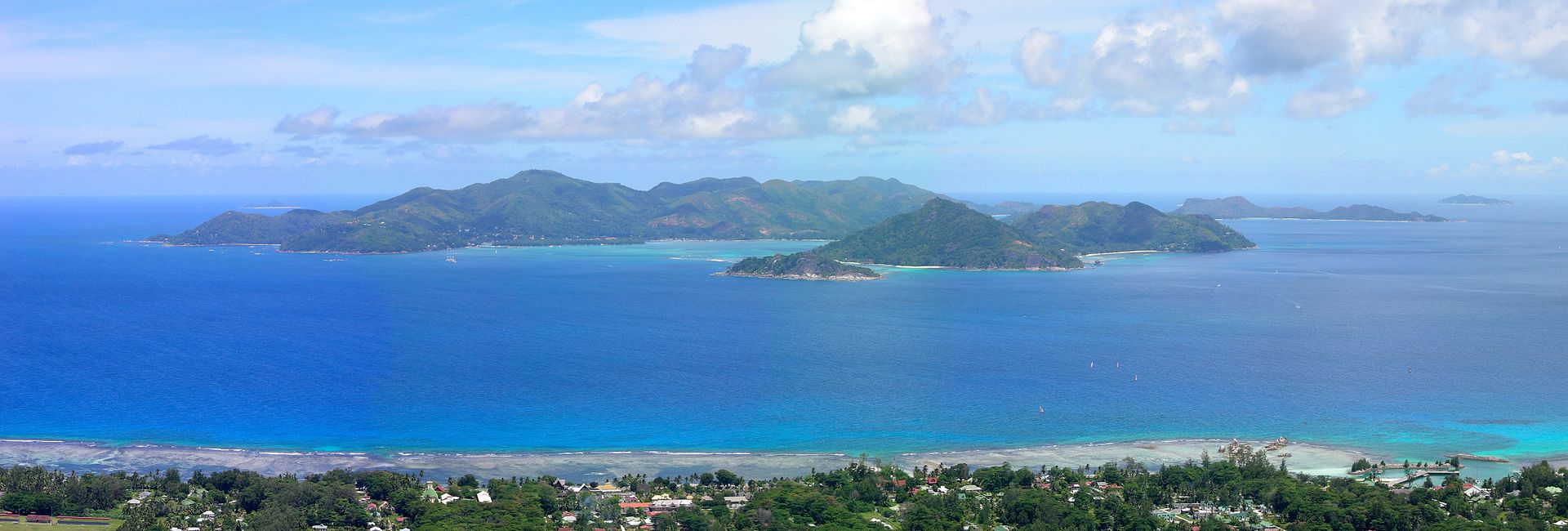219 Seychelles

Five oblique bands of blue (hoist side), yellow, red, white, and green (bottom) radiating from the bottom of the hoist side. The oblique bands are meant to symbolize a dynamic new country moving into the future. Blue represents sky and sea, yellow the sun giving light and life, red the peoples’ determination to work for the future in unity and love, white social justice and harmony, and green the land and natural environment.
Flag courtesy of the CIA World Factbook

Map courtesy of the CIA World Factbook

View of Praslin, the second largest island of the Seychelles
Government
According to Britannica, under the 1993 constitution, since amended, Seychelles is a republic. The head of state and government is the president, who is directly elected by popular vote and may hold office for up to two consecutive five-year terms. Members of the National Assembly serve five-year terms. A majority of the available National Assembly seats are filled by direct election; a smaller portion are distributed on a proportional basis to those parties that win a minimum of one-tenth of the vote. The president appoints a Council of Ministers, which acts as an advisory body. The country is divided into 25 administrative divisions.
The Seychellois judiciary includes a Court of Appeal, a Supreme Court, and Magistrates’ Courts; the Constitutional Court is a branch of the Supreme Court.
Suffrage is universal; Seychellois are eligible to vote at age 17. Women participate actively in the government of the country and have held numerous posts, including positions in the cabinet and a proportion of seats in the National Assembly.
The People’s Party (formerly the Seychelles People’s Progressive Front) was the sole legal party from 1978 until 1991. It is still the country’s primary political party, but other parties are also active in Seychellois politics, including the New Democratic Party (formerly the Seychelles Democratic Party), the Seychelles National Party, and the Seychelles Movement for Democracy.
Seychelles Civil Aviation Authority (SCAA)
The Seychelles Civil Aviation Authority (SCAA) was established under the Civil Aviation Authority Act, 2005, as an administrative and financial body corporate to provide for the services, facilities and regulation of civil aviation activities in Seychelles with the power to do anything for the purpose of discharging or facilitating the discharge of its functions. The SCAA and its affairs are administered by a CEO reporting to a Board of Directors appointed by the Minister responsible for Civil Aviation. The development of Civil Aviation in Seychelles started in 1972 with the opening of the Seychelles International Airport. Seychelles became a Contracting State to the International Civil Aviation Organization (ICAO) Chicago Convention in 25th May 1977. And as a Contracting State, Seychelles operates within the established privileges and obligations of the Chicago Convention articles, annexes and applicable standards.
Airspace
SkyVector – Google Maps – ADS-B Exchange
ICAO countries publish an Aeronautical Information Publication (AIP). This document is divided into three parts: General (GEN), En Route (ENR) and Aerodromes (AD). ENR 1.4 details the types of airspace classes they chose to adopt from classes A through G.
Drone Regulations
Advanced Air Mobility (AAM) Regulations & Policies
None found by the author.
However, should you, the reader, happen to stumble across something to the contrary, please email the author at FISHE5CA@erau.edu and you may be mentioned in the ACKNOWLEDGEMENTS section of this book by way of thanks for contributing to this free eBook!
Advanced Air Mobility (AAM) News
2023 – Adacel’s Aurora ATM System Approved for use in the Seychelles
Short Essay Questions
Scenario-Based Question
You have been hired by a Drone Startup Company. Your boss has immediately assigned this job to you.
They need you to prepare a one-page memo detailing the legalities of using a drone to film in Seychelles.
They need you to mention any national laws and local ordinances.
They specifically want to know what airspace (insert pictures) you will be operating in and whether or not you need an airspace authorization.
Does it matter whether or not you are a citizen of the country?
Lastly, there is a bonus for you if, as you scroll through this chapter, you find any typos or broken links!
Short Essay Questions
- What are the drone categories?
- How is registration addressed?
- How is remote ID addressed?
- What are the model aircraft rules?
- What are the commercial drone rules?
- Are there waivers or exemptions to the rules? If so, for what?
- Would you share a link to an interactive airspace map?
- How is BVLOS addressed?
- How can you fly drones at night?
- How can you fly drones over people?
- Where do you find drone NOTAMs?
- What are the rules for drone maintenance?
- What are the rules for an SMS program?
- What are some unique rules not mentioned above?
- What are the C-UAS rules?
- What are the AAM rules?

